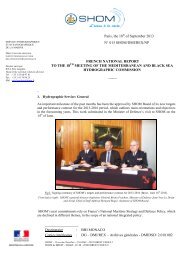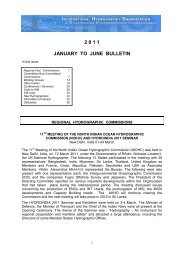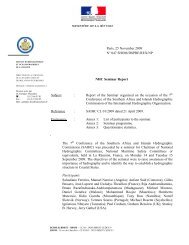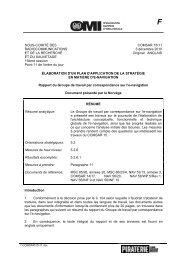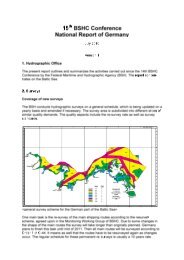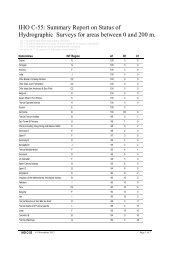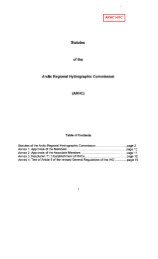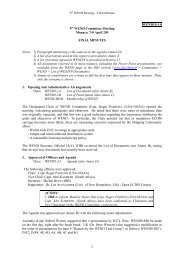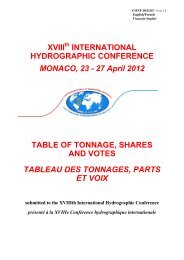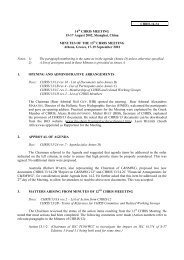The Relevance of Hydrography to UNCLOS
The Relevance of Hydrography to UNCLOS
The Relevance of Hydrography to UNCLOS
You also want an ePaper? Increase the reach of your titles
YUMPU automatically turns print PDFs into web optimized ePapers that Google loves.
23. <strong>The</strong> problems would be more difficult, however, with regard <strong>to</strong> the delimitation between<br />
states <strong>of</strong> EEZ and continental shelf. If for the delimitation <strong>of</strong> terri<strong>to</strong>rial sea the rule <strong>of</strong><br />
“median line” seems <strong>to</strong> be clear, the dominant rule for the delimitation <strong>of</strong> EEZ and<br />
continental shelf, however, is “<strong>to</strong> achieve an equitable solution” (Article 74 (1) and<br />
Article 83 (1)). <strong>The</strong>re is no clear guidelines as <strong>to</strong> what is “an equitable solution”, except<br />
that it should be achieved “by agreement” between the parties.<br />
24. For the purpose <strong>of</strong> safety <strong>of</strong> navigation, hydrographic survey is crucially important <strong>to</strong><br />
identify and map out those features and characteristic <strong>of</strong> each body <strong>of</strong> waters. It is<br />
extremely significant in the area <strong>of</strong> traffic density, such as in the straits <strong>of</strong> Malacca and<br />
Singapore and in other straits <strong>of</strong> Indonesia which are heavily navigated, either by<br />
national or foreign shipping entities. <strong>The</strong> hydrography survey is also very significant for<br />
underwater navigation, particularly in the deeper waters <strong>of</strong> Indonesia in the eastern<br />
provinces.<br />
25. Hydrographic survey is also significant with regard <strong>to</strong> the possible exploration and<br />
exploitation <strong>of</strong> the seabed area and its subsoil. Such activities would depend a great<br />
deal on the development <strong>of</strong> technology, and more countries are developing technologies<br />
for exploration and exploitation <strong>of</strong> ocean resources deeper and deeper from the surface <strong>of</strong><br />
the sea. Hydrographic knowledge with regard <strong>to</strong> bot<strong>to</strong>m <strong>to</strong>pography as well as bot<strong>to</strong>m<br />
currents and other oceanographic and geological knowledge are very significant and<br />
influential in these endeavors.<br />
26. In these contexts, it is also important <strong>to</strong> note the provisions <strong>of</strong> Article 121 <strong>of</strong> <strong>UNCLOS</strong><br />
with regard <strong>to</strong> the differentiation between “islands” and “rocks”. An island is defined<br />
as “a naturally formed area <strong>of</strong> land, surrounded by water, which is above water at high<br />
tide”. An island can have terri<strong>to</strong>rial sea, the contiguous zone, EEZ, as well as continental<br />
shelve/continental margin. On the other hand, Article 121 (3) apparently differentiates<br />
between rocks which can “sustain human habitation or economic life <strong>of</strong> their own”<br />
and those rocks which can not. Rocks which can not sustain human habitation or<br />
economic life <strong>of</strong> their own, can not be considered “islands”, and therefore they can not<br />
have economic zone or continental shelve. It is not clear whether there is a rock that can<br />
sustain human habitation or economic life <strong>of</strong> their own. Artificial islands “or” rocks<br />
6



